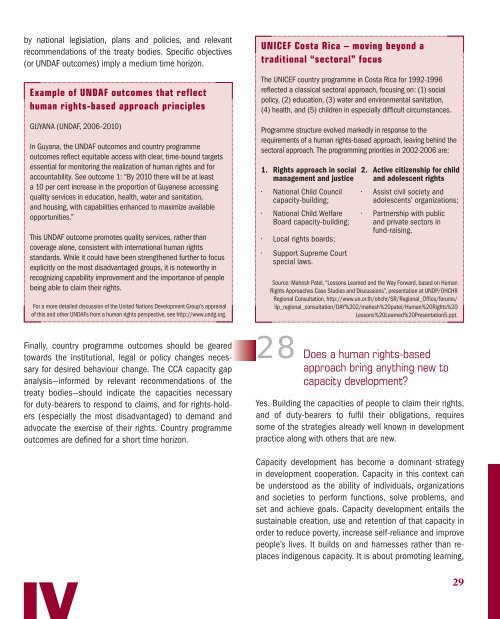Frequently Asked Questions on Human Rights-Based Approach
Frequently Asked Questions on Human Rights-Based Approach
Frequently Asked Questions on Human Rights-Based Approach
- No tags were found...
Create successful ePaper yourself
Turn your PDF publications into a flip-book with our unique Google optimized e-Paper software.
y nati<strong>on</strong>al legislati<strong>on</strong>, plans and policies, and relevantrecommendati<strong>on</strong>s of the treaty bodies. Specific objectives(or UNDAF outcomes) imply a medium time horiz<strong>on</strong>.Example of UNDAF outcomes that reflecthuman rights-based approach principlesGUYANA (UNDAF, 2006–2010)In Guyana, the UNDAF outcomes and country programmeoutcomes reflect equitable access with clear, time-bound targetsessential for m<strong>on</strong>itoring the realizati<strong>on</strong> of human rights and foraccountability. See outcome 1: “By 2010 there will be at leasta 10 per cent increase in the proporti<strong>on</strong> of Guyanese accessingquality services in educati<strong>on</strong>, health, water and sanitati<strong>on</strong>,and housing, with capabilities enhanced to maximize availableopportunities.”This UNDAF outcome promotes quality services, rather thancoverage al<strong>on</strong>e, c<strong>on</strong>sistent with internati<strong>on</strong>al human rightsstandards. While it could have been strengthened further to focusexplicitly <strong>on</strong> the most disadvantaged groups, it is noteworthy inrecognizing capability improvement and the importance of peoplebeing able to claim their rights.For a more detailed discussi<strong>on</strong> of the United Nati<strong>on</strong>s Development Group’s appraisalof this and other UNDAFs from a human rights perspective, see http://www.undg.org.UNICEF Costa Rica – moving bey<strong>on</strong>d atraditi<strong>on</strong>al “sectoral” focusThe UNICEF country programme in Costa Rica for 1992-1996reflected a classical sectoral approach, focusing <strong>on</strong>: (1) socialpolicy, (2) educati<strong>on</strong>, (3) water and envir<strong>on</strong>mental sanitati<strong>on</strong>,(4) health, and (5) children in especially difficult circumstances.Programme structure evolved markedly in resp<strong>on</strong>se to therequirements of a human rights-based approach, leaving behind thesectoral approach. The programming priorities in 2002-2006 are:1. <strong>Rights</strong> approach in socialmanagement and justice• Nati<strong>on</strong>al Child Councilcapacity-building;• Nati<strong>on</strong>al Child WelfareBoard capacity-building;• Local rights boards;• Support Supreme Courtspecial laws.2. Active citizenship for childand adolescent rights• Assist civil society andadolescents’ organizati<strong>on</strong>s;• Partnership with publicand private sectors infund-raising.Source: Mahesh Patel, “Less<strong>on</strong>s Learned and the Way Forward, based <strong>on</strong> <strong>Human</strong><strong>Rights</strong> <strong>Approach</strong>es Case Studies and Discussi<strong>on</strong>s”, presentati<strong>on</strong> at UNDP/OHCHRRegi<strong>on</strong>al C<strong>on</strong>sultati<strong>on</strong>, http://www.un.or.th/ohchr/SR/Regi<strong>on</strong>al_Office/forums/llp_regi<strong>on</strong>al_c<strong>on</strong>sultati<strong>on</strong>/DAY%202/mahesh%20patel/<strong>Human</strong>%20<strong>Rights</strong>%20Less<strong>on</strong>s%20Learned%20Presentati<strong>on</strong>5.ppt.Finally, country programme outcomes should be gearedtowards the instituti<strong>on</strong>al, legal or policy changes necessaryfor desired behaviour change. The CCA capacity gapanalysis—informed by relevant recommendati<strong>on</strong>s of thetreaty bodies—should indicate the capacities necessaryfor duty-bearers to resp<strong>on</strong>d to claims, and for rights-holders(especially the most disadvantaged) to demand andadvocate the exercise of their rights. Country programmeoutcomes are defined for a short time horiz<strong>on</strong>.28 Does a human rights-basedapproach bring anything new tocapacity development?Yes. Building the capacities of people to claim their rights,and of duty-bearers to fulfil their obligati<strong>on</strong>s, requiressome of the strategies already well known in developmentpractice al<strong>on</strong>g with others that are new.Capacity development has become a dominant strategyin development cooperati<strong>on</strong>. Capacity in this c<strong>on</strong>text canbe understood as the ability of individuals, organizati<strong>on</strong>sand societies to perform functi<strong>on</strong>s, solve problems, andset and achieve goals. Capacity development entails thesustainable creati<strong>on</strong>, use and retenti<strong>on</strong> of that capacity inorder to reduce poverty, increase self-reliance and improvepeople’s lives. It builds <strong>on</strong> and harnesses rather than replacesindigenous capacity. It is about promoting learning,29
















